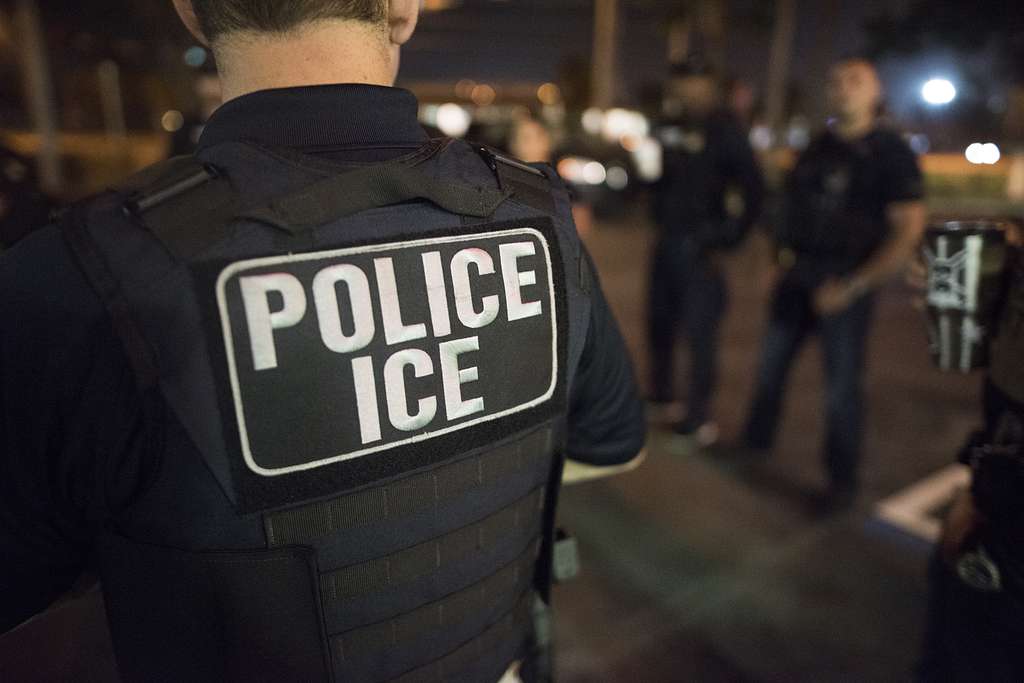How Trump Is Disappearing Migrants

Published by The Lawfare Institute
in Cooperation With

On March 15, the Trump administration flew more than 200 Venezuelan citizens to El Salvador, in violation of U.S. law and a court order from District Judge James Boasberg. The next morning, El Salvador President Nayib Bukele taunted the judge on X: “Oopsie … too late.” Bukele posted a video of the shackled prisoners being marched off a plane and into El Salvador’s Terrorism Confinement Center (CECOT), where they were forcibly shaved by guards wearing face masks.
The Trump administration’s rendition of migrants to a notorious prison in violation of a judge’s order was a dramatic escalation of a disturbing trend. In its effort to create a regime of “mass deportations,” the Trump administration is increasingly arresting, imprisoning, and transferring migrants incommunicado, and often without official acknowledgment. This practice—cutting people off from any ability to communicate with family members, lawyers, courts, or the outside world in general—has spanned multiple locations in Central America, to Guantánamo Bay, to Border Patrol holding cells, to Immigration and Customs Enforcement (ICE) detention centers.
Incommunicado and unacknowledged detention make it difficult or impossible for people to invoke their constitutional rights and statutory protections under U.S. immigration law. If detainees cannot speak to their lawyers, their families, or anyone but their jailers, they cannot tell anyone if they are beaten, tortured, denied medical care or adequate food and water, or threatened with deportation to a country where they may face even worse abuses. They cannot file lawsuits or otherwise assert their rights in court. They cannot obtain evidence proving that they are not gang members, or that they have lawful immigration status. If family members and counsel can’t find or speak to their clients, they cannot do so either.
Undocumented migrants are at greatest risk, but without procedural protections, longtime U.S. residents, people with legal status, and even U.S. citizens also get caught in the net.
Even before President Trump’s second term, human rights and civil liberties groups argued that some U.S. immigration detention and deportation practices could amount to “enforced disappearances” under international law. Enforced disappearance, which is itself a severe human rights violation, most often leads to other abuses, including torture, indefinite detention, and murder. This “deprivation of liberty” and “concealment of the fate or whereabouts of the disappeared person” place the person in question “outside the protection of the law,” making them especially vulnerable to the aforementioned abuses.
Enforced disappearance is a tool of dictatorships and antithetical to a free society that guarantees fundamental rights to everyone. It is essential that Congress, courts, the press, and the public oppose the administration’s attempt to place people beyond the law’s protection—in all cases, regardless of the location where they are detained, or the legal argument the administration makes to justify its actions.
“Alien Enemies” and a Salvadoran “Mega-Prison”
The Trump administration’s purported legal basis for transferring most of the Venezuelan prisoners to El Salvador is the Alien Enemies Act, a law that dates back to 1798 and has been invoked only three times in U.S. history. By its own terms, the law applies only when there is a “declared war” or “invasion or predatory incursion” of the United States by “any foreign nation or government.” In those cases, the law empowers the president to detain, remove, or take other measures against the citizens “of the hostile nation or government” in question.
On March 14, Trump signed a proclamation that attempted to invoke the Alien Enemies Act against a Venezuelan criminal organization, Tren de Aragua. Notably, the White House only published the proclamation on the White House website at 4 p.m. the next day. Federal courts have now found that the proclamation was legally invalid for multiple independent reasons, including the lack of any military conflict with or armed attack from Venezuela or Tren de Aragua, and the lack of due process for accused members of the gang. But the Trump administration began facilitating the deportation of Venezuelan citizens as “enemy aliens” even before it was published.
In many ways, the removals of the Venezuelan citizens to El Salvador more closely resembled the CIA’s “extraordinary renditions” of terrorism suspects to be tortured in foreign countries than either ordinary deportations or past invocations of the Alien Enemies Act. Rather than being interned in the United States or removed to their home countries, the men (and a few women) were transferred to a country where they did not have citizenship and did not face criminal charges. Many of them had never even set foot in El Salvador before. Still, they were sent to CECOT without any opportunity to seek protection under the Convention Against Torture or other treaties or statutes forbidding refoulement to persecution. The United States is paying for their imprisonment.
The prisoners had no opportunity to refute the allegations against them in any court, nor were most of them even told that they were being deported to El Salvador. Many seem to be completely innocent, with relatives and attorneys submitting affidavits and other proof that they lacked a criminal record in the United States and/or Venezuela. In the cases in which the details have been made public, the government’s belief that the men were gang members seemed to rest primarily on them having tattoos—of roses, crowns, a hummingbird, an autism awareness ribbon, and in honor of the Real Madrid soccer team, among others. (Notably, experts on Tren de Aragua have explained that the gang does not identify members through tattoos.)
CECOT is both a black hole and a popular backdrop for propaganda videos by the Salvadoran regime and recently U.S. Secretary of Homeland Security Kristi Noem. There are no attorney visits, no family visits or phone calls, and no sunlight, ever. Inmates are locked into overcrowded cells with metal bunks for 23 and a half hours a day. Bukele and other government officials have repeatedly said that no one will ever be freed from CECOT, and they have ignored courts’ orders to release prisoners. “Human Rights Watch is not aware of any detainees who have been released from that prison,” according to a recent court declaration from its Americas Division director, Juanita Goebertus. (There is now one exception to this: Kilmer Abrego Garcia, a Maryland father flown to El Salvador despite an immigration judge granting him withholding of removal to that country, was transferred to another El Salvador prison and allowed to briefly meet with Sen. Chris Van Hollen).
Because of these restrictions, there are no firsthand accounts from detainees of their treatment in CECOT. Despite this limited access, human rights groups have reported that torture and inhumane treatment are pervasive in the country’s prisons, and Gobertus said she believes that people detained in CECOT experience “torture, ill-treatment, incommunicado detention, severe violations of due process and inhumane conditions, such as lack of access to adequate healthcare and food.”
Guantánamo Bay
For the first time in its history, the Trump administration is using the U.S. Naval Base at Guantánamo Bay to detain migrants arrested in the United States.
The first flight carrying migrants from the U.S. to Guantánamo landed on Feb. 5. Detainees were held incommunicado until Feb. 17, when ACLU lawyers who filed a habeas corpus case challenging the Guantánamo detentions were granted one-hour phone calls with three of their clients. The government later handed out a hotline number for other detainees to seek legal counsel, but according to a declaration from the American Bar Association, the hotline had received no calls and ICE had not confirmed it was functional—which begs the question: what if detainees had called, but no one picked up?
Conditions for the detainees were dire. Most were taken to Camp 6, a military prison used to hold accused “enemy combatants” detained after Sept. 11, 2001. Military guards kept them locked in their bare, windowless cells for 23 hours a day and ignored their pleas to call their families or speak to lawyers. Some of the men became desperate: Duran Arapé told NPR that he was beaten by guards, took part in a five-day hunger strike, and attempted to kill himself by cutting his wrists. Two other detainees described being placed into a restraint chair as punishment for protesting. Conditions at the Migrant Operations Center, where the government held detainees it deemed “low risk,” were also terrible, with prisoners forced to undergo humiliating strip searches to leave their cells and nonexistent medical care.
Since its first transfer of detainees to the base on Feb. 5, the government has emptied and refilled the migrant prisons at Guantánamo several times. Most of the first group of 178 detainees were deported to Venezuela. Others have been transferred back to facilities in the U.S., for reasons the government never publicly explained.
It may not be coincidental that the prison was empty the day a federal court heard arguments on motions to order access to counsel and forbid new transfers to Guantánamo. The court denied both, finding that the plaintiffs could not show “irreparable harm” given that there was no one currently detained at the base. (The lead plaintiff in one of those cases, Maiker Espinoza Escalona, was one of 17 Venezuelan and Salvadoran men flown to Guantánamo and then to CECOT on March 30, on the basis of immigration courts’ orders of removal rather than the Alien Enemies Act. His partner, Yorely Bernal, has been deported to Venezuela; their 2-year-old daughter is in foster care in the United States.)
The Trump administration may be scaling down its initial ambitions to detain 30,000 migrants in Guantánamo given the logistical obstacles (since the base is cut off from the rest of Cuba, nearly all supplies must be shipped or flown) and exorbitant expense. But people are still being held there without adequate access to counsel. Meanwhile, the administration is also reportedly planning to ramp up detention on military installations within the United States, starting with up to 10,000 people in Fort Bliss, near El Paso, Texas. (ICE recently awarded, then canceled, a multibillion-dollar contract to build a tent camp there—but officials said this was only a temporary setback.)
Deportations to Panama and Costa Rica
The Trump administration has also flown several planes full of Asian and African asylum-seekers to Panama and Costa Rica. In the face of threats to retake the Panama Canal and impose tariffs, both countries agreed.
Most of the deportees to Panama had their passports and cell phones confiscated. Initially, they were locked in a hotel in Panama City and kept under military guard. Journalists who managed to interview them using a hidden cell phone learned that the detainees had been deprived of any right to seek asylum under U.S. law, despite the fact that many of them had strong cases. These migrants included Iranian converts to Christianity who were in danger of execution for apostasy if they were sent back to Iran, and Afghan women and girls who feared persecution or death if returned to Taliban-controlled Afghanistan.
Although Panamanian law forbids detention for more than 24 hours without a court order, migrants said they had been locked in the hotel for days and described it as a “prison.” On Feb. 18, 97 people, including eight children, were bused from the hotel to a camp in the jungle with “primitive” conditions—“it looks like a zoo, there are fenced cages,” said one detainee. (The Panamanian government initially denied that it was detaining the migrants, but eventually agreed to release them after human rights lawyers sued. Those still in Panama have been given short-term visas and are living in a shelter in the capital. They reportedly went door to door to foreign embassies seeking asylum, without success.)
Deportees to Costa Rica are also in limbo and have been denied the right to seek asylum in any country. According to Human Rights Watch, as of mid-March they were staying in a “reception center” where they are provided shelter and food and have access to their cell phones, but their passports have been confiscated by the Costa Rican government. The government of Costa Rica later provided permits that allowed migrants to leave the center but did not provide permission to work.
The U.S., meanwhile, is reportedly in discussions with Libya and Rwanda to send deportees there and has already sent one Iraqi refugee to Rwanda.
Border Patrol Jails
Before Trump was even inaugurated, Gregory Bovino, the chief patrol agent for U.S. Border Patrol's El Centro sector, acting without authorization from Border Patrol headquarters or collaboration with ICE, announced what he called “Operation Return to Sender.” For several days in January, Border Patrol officers from El Centro traveled hundreds of miles from the U.S.-Mexico border to detain day laborers in parking lots and pull over farmworkers on the highway. Some of them were eventually expelled from the United States.
Theoretically, the Border Patrol can set up checkpoints within 100 miles of any land or coastal border and make arrests even further inland—but this authority is almost never used along the coasts given the lack of people who enter the United States that way. Bovino wanted to change that. “It was a proof of concept,” David Kim, Bovino’s assistant chief patrol agent, told a San Diego-based journalist. “Testing our capabilities, and very successful. We know we can push beyond that limit now as far as distance goes.”
A Department of Homeland Security spokesperson claimed that the raids associated with the “operation” were “highly targeted.” Witnesses, however, reported that Border Patrol agents were randomly profiling and temporarily detaining farmworkers, day laborers, and other people with dark skin tones—in some cases using violence. Border Patrol documents showed that the agency had no prior knowledge of the criminal or immigration history of 77 of the 78 people it arrested; the 78th had a previous deportation order.
According to a lawsuit filed by the United Farm Workers and the ACLU of Southern California, Border Patrol agents arrested people who could not prove their immigration status and drove many of them hundreds of miles to a Border Patrol station just north of the U.S.-Mexico border. The detainees were held for up to three days in windowless concrete cells where the lights were always on, where concrete benches were the only furniture, and where aluminum blankets were the only bedding.
The complaint alleged that agents refused detainees’ requests to call their families or speak to lawyers or judges, and told them they would be imprisoned for months or years if they did not sign forms they were not allowed to read agreeing to “voluntary departure” to Mexico. Four plaintiffs—who had lived in the United States for over a decade—and up to 40 other people signed. They are now in Mexico, separated from their families (including U.S. citizen children) without any clear means of reuniting.
Border Patrol holding cells—which are designed for short-term detention but sometimes used to hold people for a week or more—have almost always had poor conditions and been largely cut off from the outside world. Only in June 2024 did ICE make it possible to search for migrants in CBP custody through the agency’s Online Detainee Locator System. Even then, the search engine listed only people detained by CBP for at least 48 hours, and failed to provide the specific location where detainees were held, or any reliable means for attorneys to contact them. The few calls to lawyers that people managed to place from CBP custody largely stopped after Trump took office.
Since Trump’s inauguration, CBP has conducted numerous raids in locations in which they previously rarely operated—namely in coastal cities such as Washington, D.C., and New York, as well as along a Mississippi highway. They have also begun more aggressive operations at checkpoints, including one case where CBP detained and deported a 10-year-old U.S. citizen recovering from brain cancer along with her entire family.
ICE Jails and Expedited Removals
ICE detention standards require that detainees be able to communicate with their lawyers and families. Still, detainees have become increasingly difficult to locate and contact.
In Baltimore, ICE agents have been holding migrants from 48 hours to nine days in cells at a federal office building, without access to medication, beds, showers, toothbrushes, or adequate food. The ACLU of New Mexico submitted a complaint in March that its attorneys could not locate 48 people who were arrested in an ICE operation in the state. Women were taken to the all-male Krome North Processing Center in Miami and held in hellish conditions; guards told them they should fake serious illness if they wanted help.
Even short periods of disappearance or incommunicado detention can have long-term legal effects because habeas corpus challenges to detention are supposed to be filed in the court nearest to where a person is being physically detained. For hours or days after their arrest, attorneys were unable to locate Mahmoud Khalil and Rumeysa Ozturk, students whom the government is attempting to deport for opposing the war in Gaza. The government used the time to transfer them to detention centers in Louisiana and now argues that habeas petitions and court orders prohibiting their transfer out of state were too late.
The stakes are even higher when, as with the Alien Enemies Act cases or under fast-track deportations through expanded “expedited removal,” a person can be removed from the United States entirely before their family or lawyer can find them, provide proof of lawful immigration status or long-term U.S. residence, challenge their deportation in any court, or make arrangements for custody of their children. Even if a judge finds that a removal or rendition violated a judicial order, a statute, or the Constitution itself, they may conclude that it is legally “too late,” in Bukele’s words.
But judges do not have to conclude that. They can order the government to use its power to return detainees from El Salvador, as two district courts have already done. They should conduct investigations into possible contempt of court, including evidence from the high-level White House officials who are likely responsible for the defiance of court orders in the El Salvador cases. Appellate courts should back district courts’ efforts to enforce their orders (the record on this is mixed so far). Finally, courts at all levels should consider the government’s history of bad faith when it argues that migrants’ fears of illegal deportations or disappearances are speculative and premature—as the Supreme Court appeared to do when it stopped another round of transfers to El Salvador at 1 a.m. on April 20.
Members of Congress also have a role to play. They can investigate, visit detention centers, and advocate for their constituents—even if it must be done from the minority, as Sen. Van Hollen’s trip to El Salvador to meet with Abrego Garcia and Salvadoran government officials demonstrates. They can refuse to write blank checks for a regime of mass rendition and disappearance by using all procedural means at their disposal to delay and oppose the reconciliation bill’s drastic increase in funds for deportation and detention. The public and the press can refuse to allow our neighbors to disappear without a fight. Otherwise, there is no reason to believe that this will end with noncitizens.
Editor's Note: This article is an updated version clarifying the American Bar Association attorney's declaration on the Guantanamo Bay detention facility hotline.





